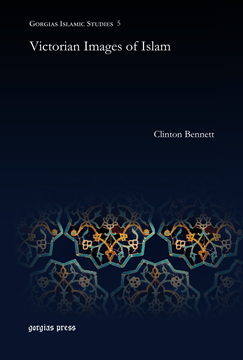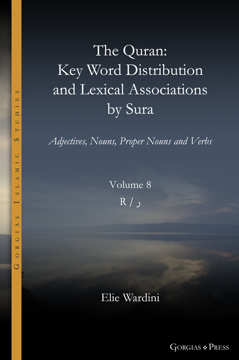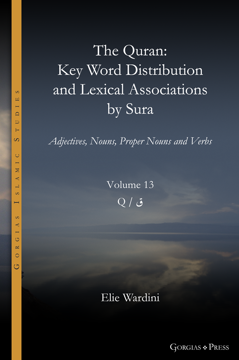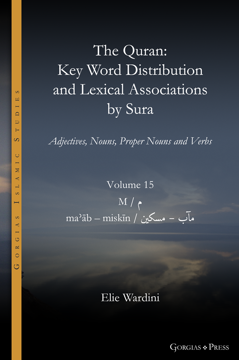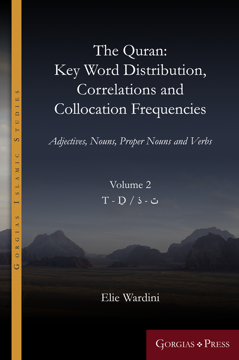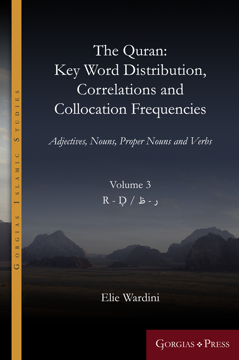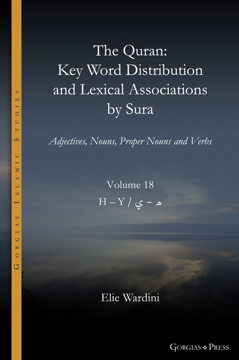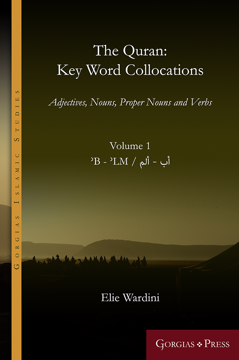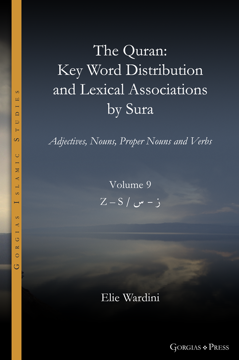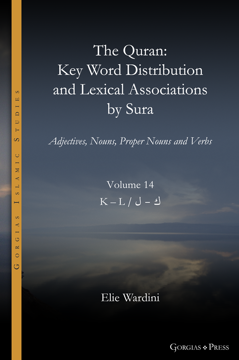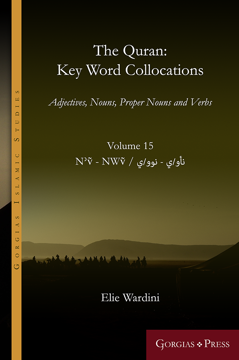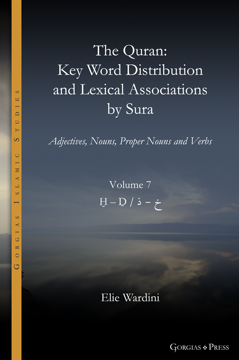Gorgias Islamic Studies
Gorgias Islamic Studies spans a wide range of subject areas, seeking to understand Islam as a complete cultural and religious unity. This series draws together political, socio-cultural, textual, and historical approaches from across disciplines. Containing monographs, edited collections of essays, and primary source texts in translation, this series seeks to present a comprehensive, critical, and constructive picture of this centuries- and continent-spanning religion.
Victorian Images of Islam
Series: Gorgias Islamic Studies 5
ISBN: 978-1-60724-673-2
Victorian perceptions of Islam were not monochrome; some saw beyond stereotypical images, others reproduced them. In this study, the accounts of six Victorians outline the contrast of the two perceptions. It suggests that presuppositions, not encounters per se, determine how we see cultural and religious others.
$172.00 (USD)
The Quran Key Word Distribution and Lexical Associations by Sura, vol. 17 of 18
Adjectives, Nouns, Proper Nouns and Verbs
By Elie Wardini
Series: Gorgias Islamic Studies 18
ISBN: 978-1-4632-4536-8
The aim with the present series, The Quran: Key Word Distribution and Lexical Associations by Sura, is to present key data related to the lexicon of the Quran, in terms of Key Word distribution and lexical associations as attested in each sura.
$175.00 (USD) $140.00 (USD)
The Quran Key Word Distribution and Lexical Associations by Sura, vol. 8 of 18
Adjectives, Nouns, Proper Nouns and Verbs
By Elie Wardini
Series: Gorgias Islamic Studies 18
ISBN: 978-1-4632-4518-4
The aim with the present series, The Quran: Key Word Distribution and Lexical Associations by Sura, is to present key data related to the lexicon of the Quran, in terms of Key Word distribution and lexical associations as attested in each sura.
$176.00 (USD) $140.80 (USD)
The Quran Key Word Distribution and Lexical Associations by Sura, vol. 13 of 18
Adjectives, Nouns, Proper Nouns and Verbs
By Elie Wardini
Series: Gorgias Islamic Studies 18
ISBN: 978-1-4632-4528-3
The aim with the present series, The Quran: Key Word Distribution and Lexical Associations by Sura, is to present key data related to the lexicon of the Quran, in terms of Key Word distribution and lexical associations as attested in each sura.
$177.00 (USD) $141.60 (USD)
The Quran Key Word Distribution and Lexical Associations by Sura, vol. 15 of 18
Adjectives, Nouns, Proper Nouns and Verbs
By Elie Wardini
Series: Gorgias Islamic Studies 18
ISBN: 978-1-4632-4532-0
The aim with the present series, The Quran: Key Word Distribution and Lexical Associations by Sura, is to present key data related to the lexicon of the Quran, in terms of Key Word distribution and lexical associations as attested in each sura.
$179.00 (USD) $143.20 (USD)
The Lexical Profile of the Suras (vol. 4)
By Elie Wardini
Series: Gorgias Islamic Studies 22
ISBN: 978-1-4632-4655-6
The aim with the present series, The Quran: The Lexical Profile of the Suras, is to present key data related to the lexicon of the suras of the Quran, in terms of Key Word distribution and lexical associations within each sura. The digital text used for this purpose is the Uthmani text of the Tanzil Quran Text. All vocalized Arabic text is quoted unaltered in any shape or form from the Tanzil text. Unvocalized Arabic text and transcriptions are my own. The Key Words are always referenced by their lemma and are sorted alphabetically according to Arabic and UNICODE order with minor adjustments for consistency. In lemmatizing the words, no attention has been given to the semantics of each word. Only on rare occasion have similar forms of words or proper nouns been separated in order to avoid confusion. In assigning each word a lemma, Classical dictionaries and Quran commentaries, as well as modern Quran dictionaries have been consulted.
$179.00 (USD)
The Quran. Key Word Distribution, Correlations and Collocation Frequencies. Vol. 2
Adjectives, Nouns, Proper Nouns and Verbs
By Elie Wardini
Series: Gorgias Islamic Studies 16
ISBN: 978-1-4632-4416-3
The aim with the present series, The Quran: Key Word Distribution, Correlations and Collocation Frequencies, is to present key data related to the lexicon of the Quran, in terms of Key Word distribution and lexical associations. The digital text used for this purpose is the Uthmani text of the Tanzil Quran Text. This text is widely used. All vocalized Arabic text is quoted unaltered in any shape or form from the Tanzil text. Unvocalized Arabic text and transcriptions are my own. In this series, each Key Word, here adjectives, nouns, proper nouns and verbs, is presented together with the following key data: Degree of Concentration, Weighted Distribution, Correlations and Collocation Frequencies. The Key Words are always referenced by their lemma and are sorted alphabetically according to Arabic and UNICODE order. In lemmatizing the words, no attention has been given to the semantics of each word. Only on rare occasion have similar forms of words or proper nouns been separated in order to avoid confusion. In assigning each word a lemma, Classical dictionaries and Quran commentaries, as well as modern Quran dictionaries have been consulted. Deciding on these is not always obvious, since classical dictionaries and commentaries sometimes either disagree or present divergent variant readings or root and lemma attributions. It is our hope and aim that this series contributes to Computational Linguistics and Digital Humanities in general, and Computational Linguistics research on the Quran in particular.
$179.00 (USD)
The Quran. Key Word Distribution, Correlations and Collocation Frequencies. Vol. 3
Adjectives, Nouns, Proper Nouns and Verbs
By Elie Wardini
Series: Gorgias Islamic Studies 16
ISBN: 978-1-4632-4418-7
The aim with the present series, The Quran: Key Word Distribution, Correlations and Collocation Frequencies, is to present key data related to the lexicon of the Quran, in terms of Key Word distribution and lexical associations. The digital text used for this purpose is the Uthmani text of the Tanzil Quran Text. This text is widely used. All vocalized Arabic text is quoted unaltered in any shape or form from the Tanzil text. Unvocalized Arabic text and transcriptions are my own. In this series, each Key Word, here adjectives, nouns, proper nouns and verbs, is presented together with the following key data: Degree of Concentration, Weighted Distribution, Correlations and Collocation Frequencies. The Key Words are always referenced by their lemma and are sorted alphabetically according to Arabic and UNICODE order. In lemmatizing the words, no attention has been given to the semantics of each word. Only on rare occasion have similar forms of words or proper nouns been separated in order to avoid confusion. In assigning each word a lemma, Classical dictionaries and Quran commentaries, as well as modern Quran dictionaries have been consulted. Deciding on these is not always obvious, since classical dictionaries and commentaries sometimes either disagree or present divergent variant readings or root and lemma attributions. It is our hope and aim that this series contributes to Computational Linguistics and Digital Humanities in general, and Computational Linguistics research on the Quran in particular.
$179.00 (USD)
The Quran Key Word Distribution and Lexical Associations by Sura, vol. 18 of 18
Adjectives, Nouns, Proper Nouns and Verbs
By Elie Wardini
Series: Gorgias Islamic Studies 18
ISBN: 978-1-4632-4538-2
The aim with the present series, The Quran: Key Word Distribution and Lexical Associations by Sura, is to present key data related to the lexicon of the Quran, in terms of Key Word distribution and lexical associations as attested in each sura.
$183.00 (USD) $146.40 (USD)
Key Word Collocations (Volume 14)
Adjectives, Nouns, Proper Nouns and Verbs
By Elie Wardini
Series: Gorgias Islamic Studies 15
ISBN: 978-1-4632-4323-4
The aim with the present series, The Quran: Key Word Collocations is to present the Quran as raw data with as little interpretation as possible. The digital text used for this purpose is the Uthmani text of the Tanzil Quran Text. In the present series, Collocation is defined as a Key Word, here adjectives, nouns, proper nouns and verbs, forming the center of a cluster with four co-occurring Key Words (1° and 2° of proximity), the first two to the left and to the right, where available. Every Collocation of each Key Word in the Quran is presented in context, as a rule with six words to the right and six to the left of it, where available or where the formatting permits. The central Key Words have been grouped by root > lemma. Classical dictionaries and Quran commentaries, as well as modern Quran dictionaries have been consulted.
$183.00 (USD)
The History, Poetry, and Genealogy of the Yemen
The Akhbar of Abid b. Sharya Al-Jurhumi
Series: Gorgias Islamic Studies 3
ISBN: 978-1-59333-394-2
The History, Poetry, and Genealogy of the Yemen is the earliest known history of pre-Islamic Yemen. Attributed to the South Arabian historian ‘Abid b. Sharya al-Jurhumi, it recounts in prose and poetry six saga cycles of ancient personages and events of the Yemen. Here, two sagas, the dispersion of Sam’s descendants from Babel to the Yemen, and the destruction of the tribes of ‘Ad and Thamud, are translated with complete annotation. The tales of Luqman b. ‘Ad and his seven vultures, Sulayman and Bilqis, the Himyarite kings, and Tasm and Jadis are given in full synopses.
$184.00 (USD)
The Lexical Profile of the Suras (vol. 6)
By Elie Wardini
Series: Gorgias Islamic Studies 22
ISBN: 978-1-4632-4659-4
The aim with the present series, The Quran: The Lexical Profile of the Suras, is to present key data related to the lexicon of the suras of the Quran, in terms of Key Word distribution and lexical associations within each sura. The digital text used for this purpose is the Uthmani text of the Tanzil Quran Text. All vocalized Arabic text is quoted unaltered in any shape or form from the Tanzil text. Unvocalized Arabic text and transcriptions are my own. The Key Words are always referenced by their lemma and are sorted alphabetically according to Arabic and UNICODE order with minor adjustments for consistency. In lemmatizing the words, no attention has been given to the semantics of each word. Only on rare occasion have similar forms of words or proper nouns been separated in order to avoid confusion. In assigning each word a lemma, Classical dictionaries and Quran commentaries, as well as modern Quran dictionaries have been consulted.
$185.00 (USD) $148.00 (USD)
The Quran Key Word Distribution and Lexical Associations by Sura, vol. 16 of 18
Adjectives, Nouns, Proper Nouns and Verbs
By Elie Wardini
Series: Gorgias Islamic Studies 18
ISBN: 978-1-4632-4534-4
The aim with the present series, The Quran: Key Word Distribution and Lexical Associations by Sura, is to present key data related to the lexicon of the Quran, in terms of Key Word distribution and lexical associations as attested in each sura.
$187.00 (USD) $149.60 (USD)
Key Word Collocations (Volume 1)
Adjectives, Nouns, Proper Nouns and Verbs
By Elie Wardini
Series: Gorgias Islamic Studies 15
ISBN: 978-1-4632-4297-8
The aim with the present series, The Quran: Key Word Collocations is to present the Quran as raw data with as little interpretation as possible. The digital text used for this purpose is the Uthmani text of the Tanzil Quran Text. In the present series, Collocation is defined as a Key Word, here adjectives, nouns, proper nouns and verbs, forming the center of a cluster with four co-occurring Key Words (1° and 2° of proximity), the first two to the left and to the right, where available. Every Collocation of each Key Word in the Quran is presented in context, as a rule with six words to the right and six to the left of it, where available or where the formatting permits. The central Key Words have been grouped by root > lemma. Classical dictionaries and Quran commentaries, as well as modern Quran dictionaries have been consulted.
$187.00 (USD)
The Lexical Profile of the Suras (vol. 1)
By Elie Wardini
Series: Gorgias Islamic Studies 22
ISBN: 978-1-4632-4649-5
The aim with the present series, The Quran: The Lexical Profile of the Suras, is to present key data related to the lexicon of the suras of the Quran, in terms of Key Word distribution and lexical associations within each sura. The digital text used for this purpose is the Uthmani text of the Tanzil Quran Text. All vocalized Arabic text is quoted unaltered in any shape or form from the Tanzil text. Unvocalized Arabic text and transcriptions are my own. The Key Words are always referenced by their lemma and are sorted alphabetically according to Arabic and UNICODE order with minor adjustments for consistency. In lemmatizing the words, no attention has been given to the semantics of each word. Only on rare occasion have similar forms of words or proper nouns been separated in order to avoid confusion. In assigning each word a lemma, Classical dictionaries and Quran commentaries, as well as modern Quran dictionaries have been consulted.
$189.00 (USD)
The Quran. Key Word Distribution, Correlations and Collocation Frequencies. Vol. 4
Adjectives, Nouns, Proper Nouns and Verbs
By Elie Wardini
Series: Gorgias Islamic Studies 16
ISBN: 978-1-4632-4420-0
The aim with the present series, The Quran: Key Word Distribution, Correlations and Collocation Frequencies, is to present key data related to the lexicon of the Quran, in terms of Key Word distribution and lexical associations. The digital text used for this purpose is the Uthmani text of the Tanzil Quran Text. This text is widely used. All vocalized Arabic text is quoted unaltered in any shape or form from the Tanzil text. Unvocalized Arabic text and transcriptions are my own. In this series, each Key Word, here adjectives, nouns, proper nouns and verbs, is presented together with the following key data: Degree of Concentration, Weighted Distribution, Correlations and Collocation Frequencies. The Key Words are always referenced by their lemma and are sorted alphabetically according to Arabic and UNICODE order. In lemmatizing the words, no attention has been given to the semantics of each word. Only on rare occasion have similar forms of words or proper nouns been separated in order to avoid confusion. In assigning each word a lemma, Classical dictionaries and Quran commentaries, as well as modern Quran dictionaries have been consulted. Deciding on these is not always obvious, since classical dictionaries and commentaries sometimes either disagree or present divergent variant readings or root and lemma attributions. It is our hope and aim that this series contributes to Computational Linguistics and Digital Humanities in general, and Computational Linguistics research on the Quran in particular.
$189.00 (USD)
The Quran Key Word Distribution and Lexical Associations by Sura, vol. 9 of 18
Adjectives, Nouns, Proper Nouns and Verbs
By Elie Wardini
Series: Gorgias Islamic Studies 18
ISBN: 978-1-4632-4520-7
The aim with the present series, The Quran: Key Word Distribution and Lexical Associations by Sura, is to present key data related to the lexicon of the Quran, in terms of Key Word distribution and lexical associations as attested in each sura.
$192.00 (USD) $153.60 (USD)
The Quran Key Word Distribution and Lexical Associations by Sura, vol. 14 of 18
Adjectives, Nouns, Proper Nouns and Verbs
By Elie Wardini
Series: Gorgias Islamic Studies 18
ISBN: 978-1-4632-4530-6
The aim with the present series, The Quran: Key Word Distribution and Lexical Associations by Sura, is to present key data related to the lexicon of the Quran, in terms of Key Word distribution and lexical associations as attested in each sura.
$192.00 (USD) $153.60 (USD)
Key Words in Context (Volume 4)
Adjectives, Nouns, Proper Nouns and Verbs
By Elie Wardini
Series: Gorgias Islamic Studies 13
ISBN: 978-1-4632-4152-0
The aim with the present series, The Quran: Key Words in Context, is to present the Quran as raw data with as little interpretation as possible. The digital text used for this purpose is the Uthmani text of the Tanzil Quran Text. Each word in the Quran is presented in context, with five words to the right and left of it. In assigning each word a root and lemma, Classical dictionaries and Quran commentaries, as well as modern Quran dictionionaries have been consulted. Words have been grouped by root > verbal form > lemma. Verbs are quoted first (when attested), each followed by its associated nominal and/or adjectival derived forms.
$198.00 (USD)
Key Words in Context (Volume 5)
Adjectives, Nouns, Proper Nouns and Verbs
By Elie Wardini
Series: Gorgias Islamic Studies 13
ISBN: 978-1-4632-4154-4
The aim with the present series, The Quran: Key Words in Context, is to present the Quran as raw data with as little interpretation as possible. The digital text used for this purpose is the Uthmani text of the Tanzil Quran Text. Each word in the Quran is presented in context, with five words to the right and left of it. In assigning each word a root and lemma, Classical dictionaries and Quran commentaries, as well as modern Quran dictionionaries have been consulted. Words have been grouped by root > verbal form > lemma. Verbs are quoted first (when attested), each followed by its associated nominal and/or adjectival derived forms.
$198.00 (USD)
Key Word Collocations (Volume 15)
Adjectives, Nouns, Proper Nouns and Verbs
By Elie Wardini
Series: Gorgias Islamic Studies 15
ISBN: 978-1-4632-4325-8
The aim with the present series, The Quran: Key Word Collocations is to present the Quran as raw data with as little interpretation as possible. The digital text used for this purpose is the Uthmani text of the Tanzil Quran Text. In the present series, Collocation is defined as a Key Word, here adjectives, nouns, proper nouns and verbs, forming the center of a cluster with four co-occurring Key Words (1° and 2° of proximity), the first two to the left and to the right, where available. Every Collocation of each Key Word in the Quran is presented in context, as a rule with six words to the right and six to the left of it, where available or where the formatting permits. The central Key Words have been grouped by root > lemma. Classical dictionaries and Quran commentaries, as well as modern Quran dictionaries have been consulted.
$199.00 (USD)
Key Word Collocations (Volume 9)
Adjectives, Nouns, Proper Nouns and Verbs
By Elie Wardini
Series: Gorgias Islamic Studies 15
ISBN: 978-1-4632-4313-5
The aim with the present series, The Quran: Key Word Collocations is to present the Quran as raw data with as little interpretation as possible. The digital text used for this purpose is the Uthmani text of the Tanzil Quran Text. In the present series, Collocation is defined as a Key Word, here adjectives, nouns, proper nouns and verbs, forming the center of a cluster with four co-occurring Key Words (1° and 2° of proximity), the first two to the left and to the right, where available. Every Collocation of each Key Word in the Quran is presented in context, as a rule with six words to the right and six to the left of it, where available or where the formatting permits. The central Key Words have been grouped by root > lemma. Classical dictionaries and Quran commentaries, as well as modern Quran dictionaries have been consulted.
$199.00 (USD)
The Lexical Profile of the Suras (vol. 7)
By Elie Wardini
Series: Gorgias Islamic Studies 22
ISBN: 978-1-4632-4661-7
The aim with the present series, The Quran: The Lexical Profile of the Suras, is to present key data related to the lexicon of the suras of the Quran, in terms of Key Word distribution and lexical associations within each sura. The digital text used for this purpose is the Uthmani text of the Tanzil Quran Text. All vocalized Arabic text is quoted unaltered in any shape or form from the Tanzil text. Unvocalized Arabic text and transcriptions are my own. The Key Words are always referenced by their lemma and are sorted alphabetically according to Arabic and UNICODE order with minor adjustments for consistency. In lemmatizing the words, no attention has been given to the semantics of each word. Only on rare occasion have similar forms of words or proper nouns been separated in order to avoid confusion. In assigning each word a lemma, Classical dictionaries and Quran commentaries, as well as modern Quran dictionaries have been consulted.
$199.00 (USD) $159.20 (USD)
The Lexical Profile of the Suras (vol. 8)
By Elie Wardini
Series: Gorgias Islamic Studies 22
ISBN: 978-1-4632-4663-1
The aim with the present series, The Quran: The Lexical Profile of the Suras, is to present key data related to the lexicon of the suras of the Quran, in terms of Key Word distribution and lexical associations within each sura. The digital text used for this purpose is the Uthmani text of the Tanzil Quran Text. All vocalized Arabic text is quoted unaltered in any shape or form from the Tanzil text. Unvocalized Arabic text and transcriptions are my own. The Key Words are always referenced by their lemma and are sorted alphabetically according to Arabic and UNICODE order with minor adjustments for consistency. In lemmatizing the words, no attention has been given to the semantics of each word. Only on rare occasion have similar forms of words or proper nouns been separated in order to avoid confusion. In assigning each word a lemma, Classical dictionaries and Quran commentaries, as well as modern Quran dictionaries have been consulted.
$199.00 (USD) $159.20 (USD)
The Quran Key Word Distribution and Lexical Associations by Sura, vol. 7 of 18
Adjectives, Nouns, Proper Nouns and Verbs
By Elie Wardini
Series: Gorgias Islamic Studies 18
ISBN: 978-1-4632-4516-0
The aim with the present series, The Quran: Key Word Distribution and Lexical Associations by Sura, is to present key data related to the lexicon of the Quran, in terms of Key Word distribution and lexical associations as attested in each sura.
$199.00 (USD) $159.20 (USD)

